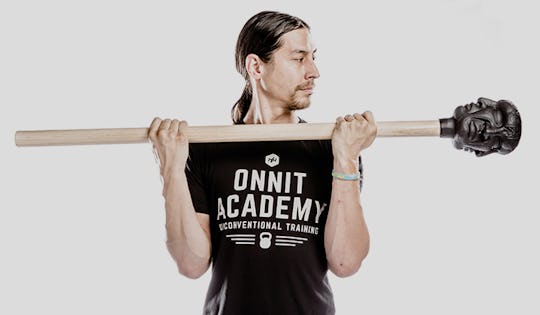The Onnit Academy brings together the best fitness experts from all over the world, and if you can’t be here to learn from them in person, using this website is the next best thing.
In an effort to help you become better acquainted with our Academy Master Trainers and the unique skills they offer, we’re going to introduce you to them one at a time.
In honor of “Steel Mace Week” here at the academy, we’re extremely proud to bring you the following interview with Onnit’s Master Steel Mace Trainer, former hip-hop artist Erik Esik Melland. Check out his workout videos on our site, and keep an eye out for the Steel Mace Certification Esik teaches, coming to a city near you.
Meet Esik Melland

Age: 36
Height: 6’2”
Weight: 172 pounds
Hometown: Seaside, CA
Fun fact: Former pro hip-hop artist who opened for groups like Fishbone.
Onnit: How did you get the nickname “Esik,” and what does it mean?
Esik: My mom used to call me “Esikya,” which means “bad boy” in Korean. It stuck with me.
Unlike most of our trainers, you weren’t a lifelong athlete or particularly interested in fitness growing up. For you, it was music.
Yeah, after high school, I didn’t want to go to college, so I moved to my cousin’s house in San Jose. I worked little jobs and tried to figure out my life. One thing I knew I enjoyed was music. If music was around everything was good. I decided I should make it a career but I needed help. I needed producers and bandmates, and other songwriters.
It was a grind. You can’t just tell yourself it’s going to work. I was spending money I didn’t even have to make it happen.
How far did you take it?
My group toured with a lot of successful hip-hop artists—Immortal Technique, Talib Kweli. We opened for Fishbone. RCA’s label was looking at my band, but we couldn’t all agree on the contract they offered. We didn’t sign, and that was the end of the band. I don’t regret it. It helped make me stronger. And music never ended for me. I still write on the side and I’ll continue to and right now I’m working on an album with Onnit.
What is your music about?
I write about the environment. The power of what people can do—being positive. It’s real easy to be negative and hate, so I talk about that.
How did you find fitness?
I wasn’t making money in music after a few years, so I had to find something else. I was desperate to find other work I was really interested in. That ended up being the body, because at that time, my body was shutting down.
As a musician, I was drinking and around people who were smoking weed all the time. I didn’t sleep. I was touring and I just wasn’t the healthiest guy. I felt like I was slipping away and that was scary. So I decided I needed to get back in shape and do it the smart way—not just say, “I’m going to lift weights.” I told myself massage therapy would get my muscles back on track. I had gotten massages and enjoyed them and became interested in getting educated on them. That led me to massage school.
Then, about six years ago, I landed at [Onnit Chief Fitness Officer] John Wolf’s gym, Wolf Fitness Systems in Salinas, California, as the team’s massage therapist.
I had worked out before but not the way they worked out! I got addicted to unconventional training to the point where if I took a day off it just felt wrong. Conventional training—barbell exercises—was too difficult for me at first. But I’ve found that when I stick with unconventional training, when I go back to conventional stuff, it almost becomes easy.

How did you discover the steel mace?
Not by choice. I had seen people using the Gada mace on social media, doing 360 swings, and I found that bizarre and interesting at the same time. I wanted to know, “What is this thing?” Obviously, it was a weight in motion, but I didn’t know what it was good for.
When Wolf and I made the switch to Onnit from Salinas, he gave me the steel mace and said, “Do something with this.” He knew how to use it but wanted to see what I could do. I was bored of every other tool so I picked it up and tried to figure it out. It took me two years to develop the steel mace curriculum the Onnit Academy has now in a way that’s safe and appropriate for everyone. Now we have a system so that everyone can use it as a recovery tool and a strength and conditioning tool.
What are the benefits of using the steel mace?
You’re moving three-dimensionally with a weight that’s completely off-center. So you’re controlling your own body through rotation, anti-rotation, purposeful rotation, and counter-rotation—usually in the same exercise. You learn how to develop these rotational skills in the best possible way—with a tool that helps you identify all the imbalances in your body.
The lever is so long that it makes it harder to control than a kettlebell or sandbag or other off-set load implements. The grip is different—you have to use two hands, and one has to be on top and the other on the bottom with palms facing different directions just to control it. With the kettlebell, you can really only swing it forward and back and to the sides. With the mace you can swing in every direction, 360 degrees. The workout for your grip and core is like nothing else.
A lot of people look at the mace and are afraid they’ll drop it on their heads, or tear their shoulders out swinging it. How do we swing the steel mace safely?
Retract and depress the shoulders. “Proud chest” is what we preach at the Academy. A lot of people lose that position when they swing the mace overhead. You still have to be mindful to keep your shoulders back and down. Letting your shoulders raise up can lead to an injury.
If you’re trying to do a 360, choke up on it and climb down the handle as you get more practice. Start at the bottom and grab it four fists up. That’s the grip you should start with.
What size steel mace should people start with?
A woman should use a seven or 10-pound mace. A man can use a 10 or 15.
What are three steel mace exercises everyone should try?
360s, switch squats, and battle lunges. The 360 is going to challenge your purposeful rotation, your counter-rotation, and anti-rotation at the same time. The switch squat challenges counter-rotation. The battle lunge works your stability from the bottom to the top of the lunge and it improves your thoracic rotation, which people tend to lose sitting at a desk in front of a computer.
All these lifts carry over to all sports, especially MMA. Rotational movements mimic throwing a punch, or a football, or swinging a bat.

How many sets and reps do you generally use?
I like going for reps when the goal is strength and time if it’s fat loss. If it’s reps, beginners can try 5 reps on each side. More advanced people can do 7 reps, and really experienced people can go for 10 reps. I never really go over 10 reps—it’s too much. On light days I’ll do 3 sets; heavier days maybe go up to 5.
If I’m going for time, I’ll lighten up the weight and work for 30–60 seconds in a set.
Can you give us a novice’s steel mace workout?
Do the exercises I mentioned—the 360, switch squat, and battle lunge as a circuit. Do 5–10 on each side with the 360s; 5–10 each side with the switch squat; 5–10 each side with the battle lunge. Rest 45 seconds after a round and repeat for 3–5 rounds.
How do you suggest a newbie to the steel mace add it to his/her existing workout?
I would start with some barbell work, then finish the workout with the mace doing one of the exercises I mentioned.
What do you know about the history of the steel mace?
It came from Persia. Their wrestlers used them. Hindus used them too. They made drawings of the elephant god Ganesha swinging the mace, which represented his power. Those guys would work up to 60 pounds. Maces were modified into scepters for their royalty, which they treated like trophies.
What was the heaviest mace you ever used?
I’ve gone up to 58 pounds on a 360. If you have the technique right, it becomes effortless in a sense. You still feel the work, but you’re not putting too much of your strength into it—you’re allowing the motion to happen with your technique.
OK, now to the important questions¦ Who’s your favorite hip-hop artist?
Del The Funky Homo Sapien. He’s the rapper on Gorillaz’ Clint Eastwood track.
Do you train to hip-hop music?
Yeah, and country music. “Cowboy” Cerrone got me into it.
Tell us about training Gordon Johnson, one of the Academy’s most impressive works-in-progress?
He was the unhealthiest human being I’ve ever met. He could barely walk to his car just to get to work. He wouldn’t tell me what his weight was when we started but he was pretty damn heavy. He needed to take a break after every five steps he took.
I told him, “I’m going to be right here waiting for you to give me 100%. I don’t care what it looks like—100% is all that counts. Give me the effort and I’ll be with you for the long run.” He promised me he’d do it and I’m still here. It’s been a little over a year and he’s lost more than 100 pounds.
How do you start training a guy who has that far to go?
Lots of hip hinging. You can’t ask a big man to squat. You can’t ask him to do a lunge. But you can definitely have him shoot his butt back and feel his hamstrings. Then he can begin to sit his butt down.
We only did body weight at first. If he needed a counterbalance, I let him hold a PVC pipe. We did cardio with striking—hitting the mitts. Then I used steel mace exercises to expand his range of motion, and now he runs on the treadmill. He does 360s and squats now. He can do reverse lunges.
He always used to say, “I can’t.” I said, “When you say that you’re only hurting yourself. When you say that it sounds like you want me to help you, but all I’m going to do is ask you to give me more. If you say ’I can’t’ I’m not going to hear you.”
What is his attitude now?
He was bitter and angry when he started. Now he’s awesome—polite and friendly. The attitude adjustment happens when you feel better. When you feel strong.
How can more people like Gordon begin to get fit?
Start moving. Move more than you think you should. Slow down your reps. Do the opposite of what your bad habits are.
You’re always cracking people up around the Academy. Do you have a favorite joke? (Keep it clean!)
Have you heard of that movie Constipation?
No?
It never came out!
Follow Esik on Instagram at @Esik831. See the link in his bio for more steel mace exercises and information on certifications—and his music!

)






